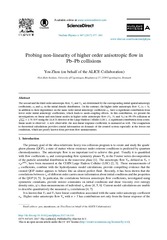Probing non-linearity of higher order anisotropic flow in Pb-Pb collisions
Acharya, Shreyasi; Adam, Jaroslav; Adamová, Dagmar; Adolfsson, Jonatan; Aggarwal, Madan M.; Aglieri Rinella, G; Agnello, Michelangelo; Agrawal, Nikita; Ahammed, Zubayer; Ahmad, N; Ahn, SU; Alme, Johan; Altenkaemper, Lucas; Arsene, Ionut Christian; Bätzing, Paul Christoph; Djuvsland, Øystein; Dordic, Olja; Helstrup, Håvard; Hetland, Kristin Fanebust; Kileng, Bjarte; Langøy, Rune; Lardeux, Antoine Xavier; Lien, Jørgen André; Lindal, Svein; Lønne, Per-Ivar; Mahmood, Sohail Musa; Milosevic, Jovan; Nesbø, Simon Voigt; Nystrand, Joakim; Rehman, Attiq Ur; Richter, Matthias Rudolph; Røed, Ketil; Røhrich, Dieter; Skaali, Toralf Bernhard; Tambave, Ganesh Jagannath; Tveter, Trine Spedstad; Ullaland, Kjetil; Velure, Arild; Wagner, Boris; Wikne, Jon Christopher; Zhang, Hui; Zhao, Chengxin; Zhou, Zhuo; Zhu, Hongsheng; Aiola, Salvatore; Akindinov, Alexander; Alam, Sk Noor; Alba, José Luis Bazo; Aleksandrov, Dimitry; Allesandro, B.; De Albuquerque, Danilo Silva; ALICE, Collaboration
Peer reviewed, Journal article
Published version

Åpne
Permanent lenke
https://hdl.handle.net/1956/17949Utgivelsesdato
2017-11Metadata
Vis full innførselSamlinger
Originalversjon
https://doi.org/10.1016/j.nuclphysa.2017.04.016Sammendrag
The second and the third order anisotropic flow, \(V_{2}\) and \(V_3\). are determined by the corresponding initial spatial anisotropy coefficients, \(\varepsilon_{2}\) and \(\varepsilon_{3}\). in the initial density distribution. On the contrary, the higher order anisotropic flow \(V_n\) \(n > 3\) , in addition to their dependence on the same order initial anisotropy coefficient \(\varepsilon_{n}\). have a significant contribution from lower order initial anisotropy coefficients, which leads to mode-coupling effects. In this contribution, we present the investigations on linear and non-linear modes in higher order anisotropic flow \(V_{4}\). \(V_{5}\) and \(V_{6}\) in Pb--Pb collisions at \(\sqrt{s_{\rm NN}} =\) 2.76 TeV using the ALICE detector at the Large Hadron Collider (LHC). A significant contribution from a non-linear mode is observed. A new observable, the non-linear response coefficient, is measured as well. The comparison to theoretical calculations provides crucial information on dynamic of the created system especially at the freeze-out conditions, which are poorly known from previous flow measurements.
